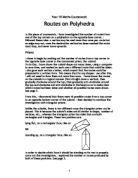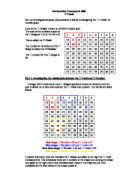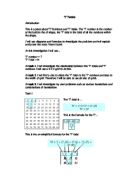Year 10 Maths Coursework
Routes on Polyhedra
In this piece of coursework, I have investigated the number of routes from one of the top corners on a polyhedron to the opposite base corner. I followed these rules: a vertice may be used more than once per route but an edge may not, once the destination vertice has been reached the route must stop, and never move upwards.
Prisms
I chose to begin by working out the number of routes from a top corner to the opposite base corner in the commonest prism, the cuboid.
To do this, I have drawn the cuboid shape out many times, using a computer to save time, and marked on each one a different route that could be taken. I also gave each vertice a letter, which meant that the routes could be presented in a written form. This means that for any shapes I use after this, I will not need to draw them out more than once. I have drawn the routes on the cuboids in a logical manner (first straight down a vertical, then gradually clockwise around the top, then gradually anti-clockwise around the top and clockwise and anti-clockwise at the base) so as to make clear which routes had been taken and whether all possible routes were drawn.
See page 2.
From this, I discovered that there were 16 possible routes from a top corner to an opposite bottom corner of the cuboid. I then decided to continue the investigation with triangular prisms.
Unlike the cuboids, there is two different ways the triangular prism can be placed. This is because the cuboid’s sides are all similar in shape, number of vertices, etc., whereas the triangular prism has sides that are both rectangles and triangles. These two positions are:
lying flat, on a rectangular face, like so:
OR
standing up, on a triangular face, like so:
In order to decide which face it should be standing on for me to properly carry out this investigation, I explored the number or routes produced by both of these positions. See page 3.
Shown below, are the diagrams and routes of the triangular prism in the positions mentioned before. The routes are shown in their written form. To work out these routes, I used the same logical method, as with the cuboids, but instead of drawing the routes, I simply wrote down the vertices passed that were through.
B
A D E
C F
Routes: BEF BAF
BEDCF BACF
BDCF BACDEF
BDEF
Total Routes: 7
B
A C
B F
E
D F
Routes: BEF
BEDF
BCF BADEF
BCADF BADF
BCADEF BACF
BCABEF BACBEDF
BCABEDF BACBEF
Total Routes: 12
The number of routes in these two positions differs greatly. The reason for this is that on the triangular based shape, the route can go any one of seven ways around the top and downwards (straight down, once clockwise then down, twice clockwise then down, complete triangle clockwise then down, once anti-clockwise then down, twice anti-clockwise then down or complete triangle and then down) then either clockwise or anti-clockwise around the base before arriving at the destination vertice.
However, the routes around the rectangular based shape can only go any one of two ways around the top and downwards (straight down or along then down) then either clockwise or anti-clockwise around the base before arriving at the destination vertice.
I then had to decide which way round’s results I would use and which way round I would use for the rest of my investigation.
I chose to use the triangular base results as I can then the base number of sides as n in the formula I will eventually work out.
To be able to work out the formula for the number of routes a prism has from top corner to opposite bottom corner, I must work out at least two more sets of results, preferably pentagonal prism and hexagonal prism, because then I will have the results for n =3, 4, 5 and 6.
Pentagonal Prism B I
Routes:
BGHI
BGFJI
BCHI BAFJI







